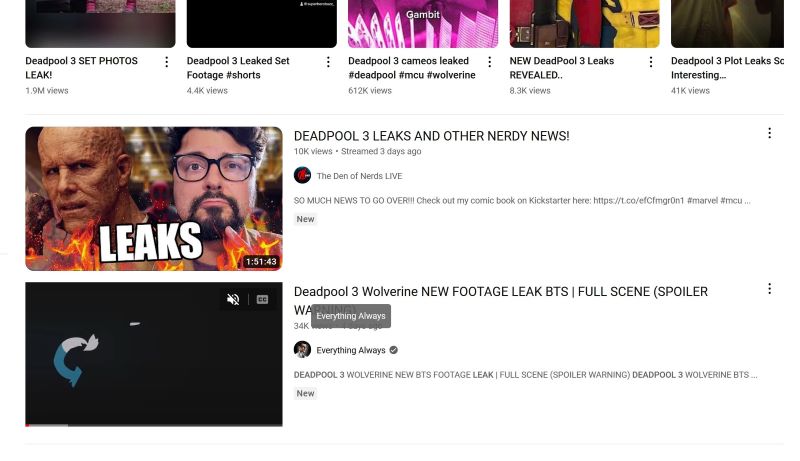
Movie fans are fanning the flames of controversy across cyberspace!
Actor Ryan Reynolds begged hackers not to publicize purloined images from his “Deadpool 3,” then proceeded to undercut them. Fanboys pounced on an allegedly poor audience response in confidential test screenings for the latest “Aquaman.” And for months, even more fanboys dissed the new Walt Disney Studios live-action “Snow White” for all kinds of sins, despite being a year and a half from cinema release.
Digital media for movie marketing, which became a serious tool two decades ago, is a mix blessing today. It offers a direct connection to fans and lower cost than traditional media, but with headaches such as toxic fans who overshadow official communications and other third-party noise.
“Deadpool 3,” which won’t hit cinema screens for a half year with its July 26 premiere date, claims to be dismayed by hackers disseminating unauthorized content recently. Faced with leaked images from the movie set, “Deadpool 3” distributor Walt Disney Studios and the movie’s star Reynolds mounted phony “leaks” to overwhelm the online world, essentially burying the bad stuff.
“In addition to ridiculing the leaks, Reynolds has coyly played the algorithm,” says an Entertainment Weekly article by Dustin Nelson. “Given how X [formerly known as Twitter] prioritizes tweets with interactions that come from high-profile accounts, his tweets — and the responses from fans — could be the top search result for anyone searching for ‘Deadpool leaks,’ et al. His posts have the potential to tamp down those frustrating leaks.”

Not to cast aspersions, but one never knows if leaks are intentionally or not in the topsy-turvy world of movie marketing. Let’s assume that, in this case, the “Deadpool 3” hack is real.
For “Aquaman and the Lost Kingdom,” the Warner Bros. Picture release set for Dec 22 domestic theatrical premiere already has a bad buzz going. It’s rated PG-13-rated and is sequel to a 2018 “Aquaman”. “More online chatter suggests that audiences have been walking out of test screenings,” says an MSN post.
A month ago, the Hollywood trade press buzzed with stories predicting a healthy $55 million-70 million “Aquaman” premiere (a three-day weekend debut), but now $32 million-42 million is the forecast. If the low-end emerges, then the big-budget movie is a financial flop given a production cost of somewhere between $160 million-205 million (not including marketing expenses).
Two decades ago, moviegoers who landed in secret industry test screenings had no easy outlet to broadcast movie secrets. But that’s not the case today in the digital age with chat boards, tweets, emails and easier direct communications with journalists.
“Snow White” is Walt Disney Studios new live-action incarnation of the studio’s iconic fairy tale story, which is penciled in for domestic release March 21, 2025 (meaning a year and a half away). A story by Nadira Goffe in Slate says that star Rachel Zegler (“West Side Story”) struck nerves in early press interviews, which have been amplified in negative social media buzz on TikTok, Facebook and X. “People of seemingly all kinds of political and racial demographics now appear to have a bone to pick with the 22-year-old actor, thanks to a few resurfaced clips of interviews in which Zegler discusses the progressive updates that the new version of ‘Snow White’ will have,” writes Goffe.
Disney traditionalists found Zegler’s knocks of the beloved 1937 animated “Snow White” disrespectful, and the woke crowd wasn’t sufficiently pacified by promised modern updates. For example, those seven dwarfs are beloved from the animated classic but are something of an embarrassment in today’s awareness of challenges facing the disabled community.

In today’s digital landscape, aficionados of sci-fi, fantasy and horror films parse content that appears online whether official or purloined. The fans try to divine plotlines, characters, costumes/props, and surprises, which are then shared with peers online. The aficionados demographic isn’t big, but creates a buzz that sways the influential press that is a societal thought-leader. The larger general audience also gets influenced.
Digital media became a significant force for Hollywood marketers about 15 years, when it first supplanted traditional media such as print newspapers (movie usage of digital goes back 30 years, but at the start it was minor).
Today, digital media such as websites, social conversations, fans swapping content, email blasts, studios dribbling out approved film content and posting official trailers are low-cost ways to reach easily-segmented and wide audiences. Compare cost to Super Bowl TV commercials at $7 million a pop next year.
“A unique characteristic is the ability for movie marketers to establish a direct connection to moviegoers when they click links in web ads or sign up for e-mail mailing lists,” says the third edition of academic/business book “Marketing to Moviegoers.” Traditional analog media are “not inherently interactive and always stood as a buffer between movie distributors and the audience.”
Leave a Reply